Check out these tips for keeping your boat’s engines gunk-free and ready to go when the weather warms again next spring.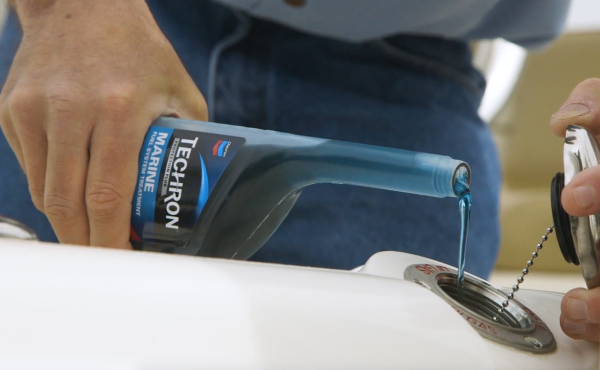 from The Fishing Wire Serious boaters know that proper care and maintenance of their rigs are the cornerstones of trouble-free boating. Whether you are an avid angler, watersports enthusiast or family cruiser, you want your boat to start up easily, run great and get great fuel efficiency every time you venture out on the water. Taking care of your boat is even more important when you’re storing it for an extended period of time. This holds true whether you’re storing your rig for the offseason or just not going to be using it for a while. The first and most important step is to use a high-performance fuel additive to stabilize your fuel and protect the entire fuel system from the build up of gum, varnish and corrosion over time. Techron Marine Fuel System Treatment was scientifically formulated by the fuel experts at Chevron to provide the highest level of protection during extended storage, while also fighting the corrosive effects of the harsh marine environment. Ethanol Issues More than 98% of gasoline sold in the United States contains ethanol, which attracts water into your boat’s fuel system. During offseason storage — or any period of infrequent operation — this water accelerates fuel oxidation, the formation of gum and varnish and can lead to corrosion in the fuel system. It left too long, this corrosion, varnish and gum can cause permanent damage to your boat’s fuel system. Some boaters attempt to prevent this by draining their fuel system in preparation for storage. This is often impractical, and it also wastes money and gasoline. Most importantly, it can actually create problems. Draining the tank exposes the metal components inside to condensation, which may accelerate fuel system corrosion. It can also cause internal components in your fuel system to dry and crack over time, leading to potential hazards and leaks. In addition, there will usually be some fuel left in the tank after draining, and it will be subject to oxidation. This can create gum and varnish that can restrict fuel injectors, gum up carburetors, and even clog the system badly enough to cause a fuel pump failure. 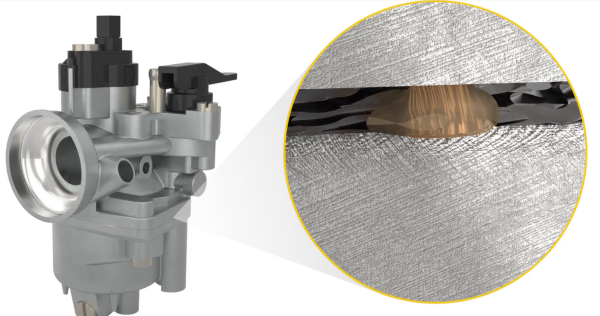 Stabilize A Full Tank Stabilize A Full TankInstead of draining the tank, add Techron Marine to a nearly empty fuel tank and then fill it up nearly to the top with quality gasoline. Leave just a little room for expansion. Then, run the engine for a few minutes to allow the treatment to circulate throughout the system. It only takes one ounce of Techron Marine to treat 10 gallons of fuel, so follow instructions and make sure you are dosing the fuel properly. Techron Marine has been scientifically engineered to keep fuel fresh for up to 24 months. Head-to-head laboratory tests have shown that Techron is also a top performer when it comes to engine and fuel system cleaning and corrosion protection in the harshest environments — especially in salt water. Because of this, Techron Marine is an ideal additive for use with every fill up, not just during storage. Used regularly, Techron Marine can help keep a boat’s fuel system and engine running clean, strong and at peak efficiency. It works in all types of gasoline-powered boats including two-stroke, four-stroke, carbureted, port- or electronic fuel-injected and direct injected engines. This versatility to stabilize fuel for extended storage and also protect boat fuel systems all season long contributed to Techron Marine winning a 2019 Top Product Award from leading trade journal Boating Industry magazine. Visit www.TechronClean.com to learn more. |
Angling Legends: St. Croix Rods


| St. Croix’s flagship family of Legend rods provide pinnacle-performance, unmatched sensitivity, and are handcrafted in the U.S.A. |
| PARK FALLS, Wisc. (February 19, 2021) – Joe Bucher knows the stuff of which fishing legends are made. The renown multi-species fishing expert from Eagle River, Wisconsin is a National Freshwater Fishing Hall of Fame Legendary Angler who targets everything from panfish, bass, walleye and muskies in freshwater to redfish, snook and sea trout on the salty side. Host of the Fishing with Joe Bucher show, now in its 31st year, he’s been a St. Croix pro-staffer for over two decades. It takes years on the water and a willingness to build on experience to excel at this game,” says Bucher, “but you also need to constantly incorporate new information and suggestions from other experts in the field. It takes a lot of problem solving, too, and I’m not just talking about fishing personalities achieving legend status,” he says. “Tackle can be legendary, too. ”Case in point is St. Croix’s evolving Legend family of freshwater and saltwater rods. Any rod containing the Legend moniker is a pinnacle performer in the St. Croix lineup, handcrafted in the USA and incorporating the finest materials, components and technologies available in a St. Croix fishing rod.“These are rods that really live up to their namesake,” says Bucher, referring to St. Croix’s Legend Tournament, Legend Elite, Legend X, Legend Xtreme, Legend Xtreme Inshore, Legend Surf, and Legend Glass series rods – the very Best of the Best Rods on Earth®. “From the second you first lay that grip in your palm and feel the weight spread evenly across your fingertips you just know they’ve been designed to help anglers catch more fish.” |

| Depending on which Legend you choose, these rods are handcrafted with St. Croix’s proprietary SCIV, SCV and SCVI carbon or St. Croix’s 100% Linear S-Glass to ensure you receive elite-level sensitivity, strength and lightweight performance. Integrated Poly Curve® (IPC®) tooling eliminates all transitional points in the rod blanks for smoother action and even more strength while further improving sensitivity. Advanced Reinforcing Technology™ (ART™) uses an exotic carbon fiber material that adds a further magnitude (10X) of strength with virtually no increase in blank diameter or weight. Use of a Fortified Resin System (FRS) combines a fortified super resin with computer operated curing ovens that provide improved temperature and time management through all stages of the curing cycle, while Taper Enhancement Technology (TET), a process perfected by St. Croix that begins with precision-cut curved-blank patterns made possible by a state-of-the-art computerized pattern cutting machine, also aids in pushing the limits of Legend blanks into the hyper-performance category. “All that is well and fine,” says Bucher, “but I think the overriding point is that St. Croix uses all this cutting-edge technology while also incorporating suggestions and insights from a top-shelf pro staff that’s on the water daily when it comes to putting their rods together. From using the most sensitive composites and glass in their blanks, to superior guide trains, designing handles that increase the transmission of the bite through the rod blank, to the parabolic curve of each stick, the research, development and willingness to incorporate feedback from the trenches really sharpened the capabilities of each and every Legend series rod. ”The result, believes Bucher, is the most sensitive, powerful, responsive and durable set of top-end fishing rods on the market with seven distinct Legend families to cover a wide range of species and techniques.“If you’re looking to budget your money for a rod or two that will let you feel the slightest strike, fish across the widest set of variables, and cover the greatest range of species and techniques, St. Croix’s Legend rods are where you begin and end your search,” says Bucher. Although Bucher uses rods from every Legend series, he does have a few favorites. Due to the incredible sensitivity derived from its SCV/SCVI blank, carbon fiber guides and Gen-2 Xtreme-Skin handle, The Legend Xtreme 7’ medium/fast (#XFS70MF) spinning rod is his first choice for any type of finesse fishing, especially lightweight jigging. |

| “I’ve caught everything from panfish and bass to seatrout, snook and 30-pound redfish on this Legend Xtreme and companion saltwater Legend Xtreme Inshore model – and it’s never been overmatched,” he states. “The real wow factor with this rod is that you can actually feel fish pick up a jig on a slack line. That alone sets it apart from all others. Just today, I was fishing on a wide-open Florida bay. I was battling the wind and current, and trying to hit my spot lock, when I popped my jig off the bottom. Somehow, I sensed a slight bump in my slack line. A huge, speckled trout had inhaled my jig. ”Of course, Bucher also has a reputation for decking monster muskies, and for that application he says the Legend Tournament Musky Downsizer 7’10” medium/fast (#LMD710MF) entry, which he helped design, can’t be beat. This rod doubles as a lunker bass stick and musky downsizer in his arsenal, allowing him to fish large lures for bigmouths and smaller musky-class lures to absolutely dominate both species.“Pick it up and it feels light like a bass rod,” says Bucher, “but put it to the test with an angry musky and it has surprising power and backbone. This rod offers the perfect combination of length, strength, and that all-important sensitivity. I’ve caught more big muskies on this one rod than most anglers catch in a lifetime. ”The Legend Xtreme series features six freshwater casting and five freshwater spinning models. Legend Xtreme Inshore includes three spinning and one casting model. These apex rods feature SCV & SCVI carbon, IPC, ART, FRS, TET, Daiwa AGS Carbon Fiber Guides, and 2nd Generation Xtreme-Skin Handles. The broad Legend Tournament Series is an angler favorite. There are Legend Tournament models optimized for almost any bass, walleye, musky, and inshore-fishing application. These blanks are crafted from SCIV high-modulus high-strain carbon, feature IPC, ART and FRS technologies and feature both split-grips and full-cork handles, depending on the model and application. Like Bucher, Stephen Browning of Hot Springs, Arkansas, has a reputation for battling big fish and cashing checks come tourney time. “I don’t know about being a legend,” says the 21-year St. Croix pro staffer, “but I do know if you put me on a river with a St. Croix Legend rod, I’m probably going to take somebody’s money.”The fisheries biologist-turned pro angler isn’t boasting; he has 42 Top 10s in his career, which has netted not only tons of bass, but winnings over $1.4 million. |

| “St. Croix has really worked hard to incorporate the input of its pro staff in designing each Legend Series rod to give every angler the upper hand. Pick up any model and you can instantly feel it’s designed to catch more fish,” he says.Browning, too, cycles through the entire array of Legend rods each season, but has two clear favorites. One, he says, is the 7’11’ heavy power, moderate-fast Legend X casting rod (XLC711HMF), which he loves for flipping bass in grass. The other is the 6’10” medium power, moderate action Legend Glass (LGS610MM) casting rod, which he often uses for shallow cranking and running square bill plugs just above the grass. |

| “That Legend X 7’11” is so well balanced, it allows you to flip heavy baits with absolutely no splash,” he explains. “It’s also super-sensitive. With flippin’ and pitchin’, especially on pressured water, you don’t always feel the bite. You just lift your lure slightly and sense a little extra weight. With the Legend X, you can tell instantly if it’s a bass, weed or even a leaf hanging onto your jig. With the length of the rod, you can also move a lot of line, which I find to be a big help when fishing over hydrilla or other weeds in 15- to 20-foot depths – that’s my sweet spot. This rod also has plenty of power, so it’s the real deal when you need to wrestle a big one out of the slop. ”Browning is also proud of the input he had in designing the Legend Glass series. “We worked a year-and-a-half on making that rod,” he reveals. “With most square-bill and crankbait strikes, it’s the rod more than the angler that drives the hook home. You must let the rod load up on the strike before reacting, but you still need enough backbone to finish the job. Like all the Legend rods, it’s also extremely sensitive – amazingly so, considering it’s a glass blank. This 6’10” rod perfectly matches crankbaits with #4 treble hooks.” |

| It’s easy to miss some of the smaller aspects that go into making a rod so sensitive, notes Browning. On the Legend Glass 6’10”, for example, St. Croix’s 100% linear S-glass laid up with IPC mandrels has a lot to do with transmitting the bite, but so does the selection, number and placement of the Fuji® K-Series tangle-free guides. Most rods in the 6’ to 7’ class, he notes, have maybe seven guides. The Legend Glass has ten plus the rod-tip, spaced closer together. “Thanks to IPC, Its forgiving taper is perfect, too,” adds Browning. “I was absolutely sold on this rod when a 4.5-pound bigmouth smashed my lure boat-side as I was about to lift it out of the water. A lot of fish are going to rip free of the hook with a strike like that, but with my Legend Glass, I can probably land nine out of ten on those surprise strikes. That’s impressive.” St. Croix’s Legend X series features freshwater spinning and casting models incorporating hybrid SCV/SCVI carbon blanks, IPC, ART, FRS, and TET. All of these rods feature split-grip handles.Legend Glass models are designed for spinning and casting with reaction baits and feature super premium 100% Linear S-glass, IPC construction and split-grip super-grade cork handles.Bass and walleye expert, Tony Roach, from, Moose Lake, Minnesota, fishes Legend X, Legend Xtreme and Legend Glass rods on a regular basis, targeting anything that bites, from panfish and bass to walleye and pike. His favorite, however, is walleye, a passion the legendary fishing guide inherited from another legendary stick, his uncle Gary – Hall-of-Famer, Gary Roach – “Mr. Walleye” himself. |

| “I like pitching paddle tails and swimbaits for the ‘eyes,” he says, “and the Legend X 6’8” medium power, extra-fast action casting model (XLC68MXF) is ideal for that application. It’s lightweight and has great transfer from the line to the guides, down the blank and through the handle. It’s absolutely seamless in terms of transmitting the bite. With this rod, I sometimes feel shy walleye inhale my lures on a completely slack line. That rod’s sensitivity is second to none. With the exception of the new Legend Xtreme, nothing else I’ve ever fished can compare. ”Roach points to Legend X’s hybrid SCV/SCVI blanks and Fuji® Torzite® tangle-free guides as two primary reasons for the exceptional sensitivity, but notes these rods also possess amazing power. “When targeting bronzebacks and walleye, we occasionally hook big pike or even a musky from time to time. With the Legend X Series, you are never under-gunned. I make my living guiding anglers on big water. That means dealing with high winds, strong currents and big fish almost every day. When you choose a Legend series rod under those conditions, you’re giving yourself a big advantage. There’s nothing else out there that matches up.” Rick Miller from Eastman, Wisconsin, is yet another well-known tournament angler on the St. Croix pro squad. With multiple wins on the Mississippi River, he’s a force to be reckoned with wherever he decides to launch.“I’m so impressed with the sensitivity, light weight and strength of Legend rods that I use them exclusively,” says Miller. “I can use them to match any situation, target any species, and present with any technique.”Miller’s favorite Legend rod is a 7’4” heavy power, fast action casting model, which he owns in Legend Xtreme (XFC74HF), Legend X (XLC74HF) and Legend Tournament Bass (LBC74HF) series. He uses them for everything from flipping and pitching to casting frogs and even punching the weeds with weights ranging from ¼- to 1-1/4 ounces. |

| “I absolutely love these rods,” explains Miller. “I like to keep the size, action and power the same between the different series so I don’t have to make too many adjustments every time I switch lures or methods. I know what this rod does and what it should feel like, and I think that gives me consistency that leads to a significant advantage.“Quite simply, these are the most sensitive rods I’ve ever had in my hands, which makes a big difference when I ‘m bassin’ in heavy cover or tempting walleye in heavy current. In these situations, you’re looking for the slightest tick to indicate a bite. With these Legend rods, I’m confident I’ll feel every little tick –and fishing with confidence is what you need more than anything else to climb to the top of the mountain in the fishing game.” |

| When it comes to true angling legends, it takes one to know one. Whether they prefer the split-grip handle design of Legend X, full-cork handle of Legend Elite, the unique 2nd-Generation Xtreme-Skin handle and carbon fiber guide train offered by Legend Xtreme, or the vast selection of bass, walleye, musky and inshore models available in the Legend Tournament family, legendary anglers around the world choose and rely on St. Croix Legend series rods.All St. Croix Legend rods are handcrafted in the USA and carry a 15-year transferable warranty backed by St. Croix Superstar Service for legendary protection of your prized investment. See them all at your local St. Croix dealer. |

| #CROIXGEARLike the rods? You’ll love our lifestyle apparel. |
Sea Grass Restoration Promises Fishery Improvements
| By Mike Naylor, Maryland DNR from The Fishing Wire Anglers and boaters have experienced firsthand how the resurgence of SAV beds on the Susquehanna Flats has led to water so clear that the bottom of the bay is often visible 10 feet deep in midsummer. 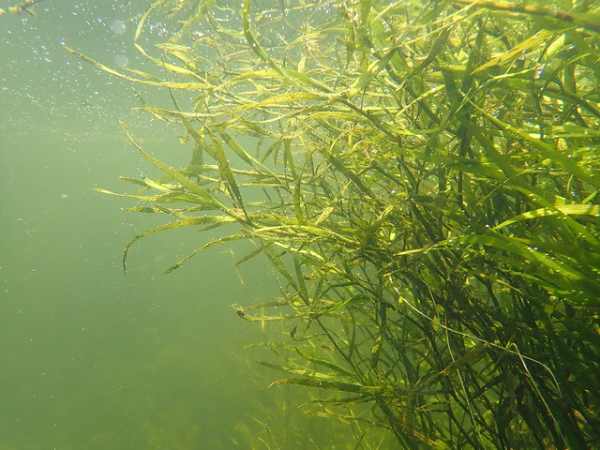 Submerged aquatic vegetation (SAV) is increasingly recognized as vital to aquatic ecosystems. Its importance is extolled during retellings of extreme weather events, e.g. how the widespread destruction of SAV following Tropical Storm Agnes in 1972 affected the Chesapeake Bay. Submerged aquatic vegetation (SAV) is increasingly recognized as vital to aquatic ecosystems. Its importance is extolled during retellings of extreme weather events, e.g. how the widespread destruction of SAV following Tropical Storm Agnes in 1972 affected the Chesapeake Bay. The benefits of healthy underwater grass populations are easily observed: lately, anglers and boaters have experienced firsthand how the resurgence of SAV beds on the Susquehanna Flats has led to water so clear that the bottom of the bay is often visible 10 feet deep in midsummer. Since the late 1990s, the Maryland Department of Natural Resources has been working with federal, state, and local partners to increase the acreage and diversity of SAV in Maryland’s part of the Chesapeake Bay. The department’s Tidewater Ecosystem Assessment Division has been doing this through direct restoration–planting plants or seeds of native SAV species in areas where they are not currently found. In the early years, this team’s efforts focused on growing plants in laboratories and schools. Plants were started either by seeds or through cloning, grown for a few months indoors until mature, and eventually planted into the bay. Growing adult plants was expensive, time-consuming, and laborious. Moving adult plants to the water from wherever they had been grown was back-breaking work. The effort needed help, so starting in 1999 the department partnered with the Chesapeake Bay Foundation to grow wild celery in Maryland schools. Students would plant and raise wild celery while doing in-class experiments, then bring their grasses to us and plant them. The “Bay Grasses in Classes” project expanded rapidly. By 2003 the partnership had 330 schools growing grasses and taking thousands of plants to many places through-out the state so the students could wade into the bay to plant them. 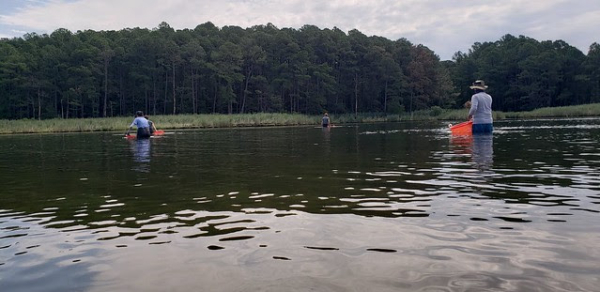 Biologists and ShoreRivers volunteers collect widgeon grass seeds near the mouth of Eastern Bay. Biologists and ShoreRivers volunteers collect widgeon grass seeds near the mouth of Eastern Bay.These efforts resulted in redhead grass beds in the Severn River, sago pondweed beds in the Magothy River, and wild celery beds in Long Creek and in several reservoirs including Piney Run Park and Clopper Lake. Some of those grass beds persist to this day, 20 years after planting. The program was successful, but expensive and time-consuming, and grant funds dwindled. 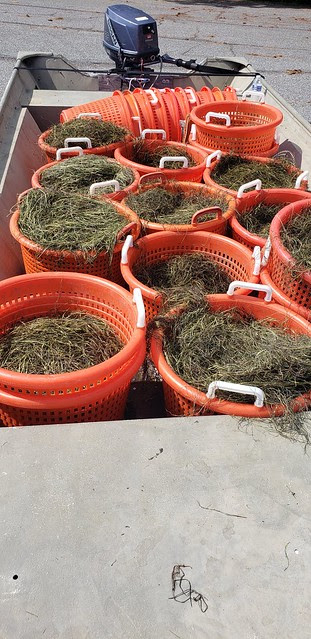 Bushels of widgeon grass flowering shoots awaiting transport for processing. To keep restoration going, the department and partners had to find simpler and less expensive techniques. These were found in scientific journals of others doing SAV restoration using seeds. Some groups were collecting the flowering shoots of eelgrass and placing them in floating mesh bags, out of which the seeds would fall when fully developed. Instead of growing plants from seeds across several months, during which they require constant care, the researchers could spend a few days collecting seed-bearing parts of plants, spread them in suitable areas, and walk away to let the seeds fend for themselves. The team adopted these techniques immediately and have been using them ever since. During this process, the team realized that planting adult plants yielded small restored beds due to the large amount of labor involved in growing and transplanting plants. After planting, managers relied on these restored plants to produce seeds. Gathering and planting seeds directly cut out the middleman. Instead of relying on a small number of plants to make seeds that could be eaten by waterfowl or blown onto shore, the team collected millions of seeds and placed them in appropriate growing areas. It worked! Every year, funded by a small grant, a two-person crew from DNR spends a few days with Mike Norman of Anne Arundel Community College planting SAV seeds in late spring, then scouting for and collecting SAV seeds from all over the bay in late summer and fall. In 2020, DNR worked with the Mid-Shore Riverkeepers and the Nanticoke Watershed Alliance to plant seeds in the Sassafras, Miles, Chester, Tred Avon, and Nanticoke rivers. DNR crews and volunteers collected millions of seeds of redhead grass, widgeon grass, sago pondweed, and wild celery. Working over the summer during the COVID-19 pandemic has been very challenging, with workers driving separately and carefully maintaining social distancing while working within the short window of time during which seeds are viable. 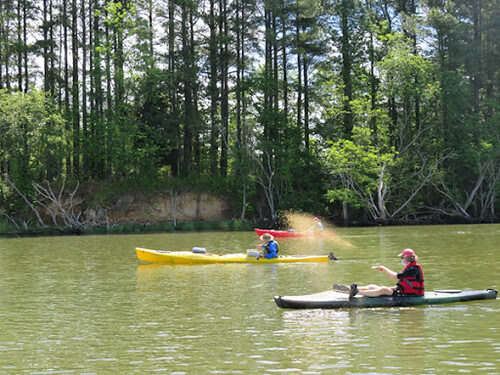 Team of biologists distributing redhead grass seeds in the Wye River, with Wye Island in the background (photo courtesy of ShoreRivers)Recent successful projects have been documented in Kirwan Creek south of Kent Narrows, in the upper Chester River, on Pleasure Island, and on Gibson Island. A roughly equal number of plantings have failed, which is a pretty good track record for in-water restoration work. As with so many things, this restoration work is further evidence that a small group of motivated people can make a big difference for the bay! dnr.maryland.gov/waters |
Fishing Alabama Lakes
I love fishing Alabama Lakes. I am constantly amazed how different they are from our lakes in middle Georgia. Coosa River lakes are full of big, hard fighting spotted bass and the water is often full of grassbeds, something we just do not see here. And the current makes a big difference in the bite, and it runs most of the time.
Tennessee River lakes are big and full of grass, too. And they have smallmouth, some of them excellent smallmouth fishing. The tailraces below the dams provide fishing that is just not available here.
Lakes in south Alabama are similar to our Eufaula and Seminole. Their tannic water is covered in the shallows by grass and cypress trees and largemouth are king.
Last week on Tuesday I fished Logan Martin on the Coosa River near Pell City. I-20 crosses its upper end and it is usually a great lake. Unfortunately, I was staying in a motel near I-20 about 40 miles from Birmingham where a tornado killed someone in a motel there. Strong storms came through the area with thunder keeping me awake most of the night, then the morning dawned bright and cold, something not good for fishing.
We had about five hours on the lake and caught some small bass, but nothing like what I had hoped.
I was on Lake Weiss last Saturday, a cold, cloudy day. Fishing was tough and disappointing. We did not catch a fish in the 43-degree water. After noon, we were fishing an area with several other bass boats nearby. They were in a local tournament. We heard two of the teams talking and both said they had not caught a fish that day. Another team we talked to said they had one little keeper. So it was not just us.
Fishing should get better soon, with longer days affecting the bass and making them want to spawn. They will start their annual movement toward spawning areas but will stay deep and not feed much until the water starts to warm. With lows most nights in the 20s and highs only in the 40s “forecast” most days for the next ten days, it will take a while.
I put forecast in quotations since it seems it is at best a guess. I call meteorologists “Weather Guessers” since that seems to describe their forecast. Last week I kept watching the guess as what the weather would be at Lake Lanier this Sunday for the Flint River Tournament and my four-night camping trip to Don Carter State Park on the lake.
It started last Monday saying lows Saturday night would be in the low 20s with snow Sunday morning, and a high Sunday of 43 and clouds all day. By Tuesday night the forecast was low of 34 Saturday night and a high of 56 Sunday with mostly sunny skies.
A few years ago we postponed a club tournament at Sinclair the following Sunday due to the forecast at meeting Tuesday night. By Sunday it was a beautiful, warm day and I went to the lake and caught several bass, including a five pounder. The next Sunday, the day we postponed the tournament to, was windy, cold and miserable. And the whole club caught fewer fish than I had caught the Sunday before!
I never make my plans based on weather guesses a few days in advance and encourage my clubs to wait to the last minute to cancel a tournament if we have to do so, and only for dangerous conditions.
Do I Need A Boat To Catch Fish On the Gulf Coast?
| No boat? No problem when you visit the Gulf Coast. by Frank Sargeant from The Fishing Wire Many anglers who visit the endless sandy beaches between Dauphin Island, Alabama, and Panama City Beach, Florida, come without boats. Trailering a large boat is a hassle, and many anglers don’t want to put their flawless $50,000 bass boat and trailer into saltwater that can corrode metal parts. But this is not a problem in several locations, thanks to resort destinations that cater to anglers and boaters. Not only are there literally hundreds of boats of all sizes for rent and for charter along the coast, there’s also very good—and free–wade-fishing or kayak fishing along much of this stretch, all the way from both sides of Dauphin Island to St. Andrews Bay at Panama City Beach. I enjoyed some great action on blues, jacks, ladyfish, trout and reds both from rental pontoons and also while wade fishing on a recent visit to Florida’s Grand Lagoon, just inside Panama City Beach Pass, the manmade cut that leads into St. Andrews Bay. I’ve had similar results in previous visits to Dauphin Island and to Orange Beach. As throughout much of the Gulf Coast, there are loads of quality accommodations here very close to the water—but one of the very few directly on the bay with docks right in front of the hotel is the upscale Sheraton Panama City Beach Golf and Spa Resort on Jan Cooley Drive. Check them out at https://www.marriott.com/hotels/hotel-information/pfnsi-sheraton-panama-city-beach-golf-and-spa-resort. 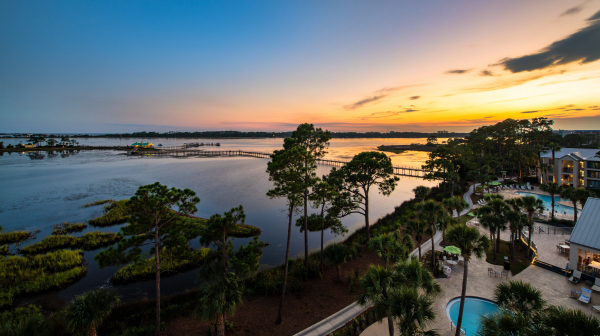 The Sheraton Panama City Beach is a great spot for anglers and boaters, with wadefishing on the premises, boat docks just across the walkway over the lagoon. The Sheraton Panama City Beach is a great spot for anglers and boaters, with wadefishing on the premises, boat docks just across the walkway over the lagoon.The hotel, rebuilt repeatedly after getting hammered by hurricanes, is now ideal for those who enjoy boating and fishing as part of their beach vacation. It’s directly on Grand Lagoon, with an extended walkway reaching out across grass flats and needle-rush marsh to the marina, and to some great wade fishing. There’s also a private beach on the lagoon here—a good spot for those who don’t like the waves and the crowds of the main beach along the Front Beach strip. (If the fish don’t bite—rare—you can always play golf or tennis or enjoy the miles of great walking paths.) Anglers also like “Flip-Flops”, an open-air bar and restaurant overlooking the lagoon, so close you can hear the mullet jump. 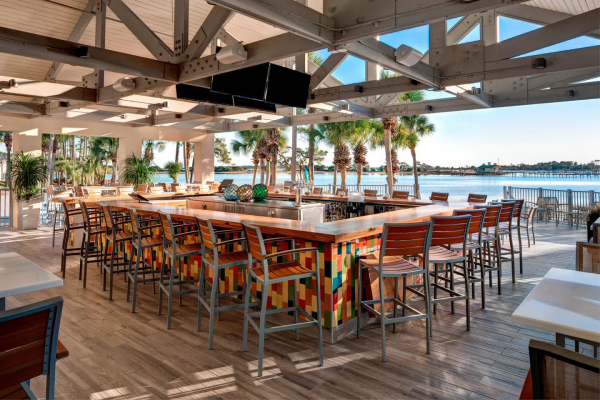 Flip Flop’s Bar and Restaurant in Panama City Beach is close enough to the lagoon to hear the mullet jump. Flip Flop’s Bar and Restaurant in Panama City Beach is close enough to the lagoon to hear the mullet jump.Alligator Point extends out from the corner where Grand Lagoon makes off to the west from St. Andrews Bay proper, and like many “elbows”, it’s a likely fishing spot. There’s grass here to several hundred yards offshore, all wadable at depths from 1 to 3 feet. For those not staying at the hotel, there’s a public access at the end of Jan Cooley Drive good for wading access or to launch a kayak. I caught trout and one big redfish throwing a Rapala Skitterwalk topwater at dawn off the point, while after the sun got high the trout and reds disappeared but several schools of 2 to 3 pound bluefish and lots of ladyfish and small jacks swarmed baits on the edge of the flats—a half-ounce Krockodile spoon caught all I wanted. This same action continues all along the north Gulf beaches until water temperature drops below about 67 degrees, which pushes the baitfish south.  Bluefish are a common catch all along the Gulf Coast so long as the baitfish are still present, which they typically are from April through early November. While wadefishing gets you to lots of fish, it’s also possible to rent kayaks and paddleboards at many locations along the coast, adding considerably to range as well as allowing you to fish deeper water if that’s where the fish are holding. Bluefish are a common catch all along the Gulf Coast so long as the baitfish are still present, which they typically are from April through early November. While wadefishing gets you to lots of fish, it’s also possible to rent kayaks and paddleboards at many locations along the coast, adding considerably to range as well as allowing you to fish deeper water if that’s where the fish are holding. 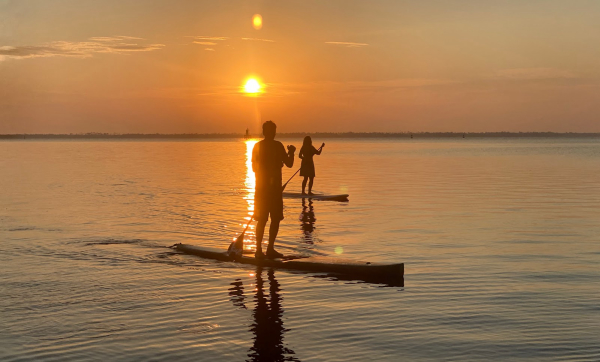 Standup paddleboards float in just inches of water, while allowing access to miles of great flats fishing all along the north Gulf Coast. Standup paddleboards float in just inches of water, while allowing access to miles of great flats fishing all along the north Gulf Coast.Fish the larger passes here and you get into other species. Deep water and lots of flow at Panama City, Destin, Pensacola, Perdido and the mouth of Mobile Bay means lots of bait and lots of big fish. Everything from 30-pound redfish to 5-foot-long king mackerel and 60-pound cobia prowl these passes, along with more big sharks than most of us want to deal with. There are also nice mangrove snapper on the deep rocks, and an occasional keeper-sized gag grouper—put down a live sardine for them on 60-pound-tackle. If all this is not enough to provide your angling fix, you can also visit the sugar sand beaches that stretch some 160 miles. Holes right along the beach hold whiting and pompano ready to grab a shrimp tail, while outside the bar big reds and cobia cruise, along with tarpon in summer. And of course all this is added to huge charter and party boat fleets at marine centers all along the coast. The big boats are ready to take you out for anything from red snapper and grouper to blackfin tuna and blue marlin.In short, there’s no need to bring a boat to the north Gulf Coast to enjoy the fishy bounty. For information on other accommodations, restaurants and area attractions in the Panama City Beach area, visit www.visitpanamacitybeach.com. For Pensacola Beach visit www.visitpensacola.com. For the Alabama coast, visit www.gulfshores.com. |
Making Up State Mottos On Fishing Trips
Crossing the Georgia state line driving home from Lake Weiss last Sunday, I was reminded of crossing many state lines on my annual trip to northern Wisconsin. For ten years I left Griffin on Labor Day and drug my boat 1100 miles north, taking about 18 hours to get to Rhinelander.
I listened to audio books on those trips, they made the long drive better. But I also paid attention to scenery and the road. When I crossed a state line each state displayed their “Welcome to __” sign and some had mottos or sayings with them. I started making up my own for each state based on my experiences in them.
Crossing into Tennessee at Chattanooga and knowing the climb then downhill run of the mountains ahead, I looked for a “Welcome to Tennessee – Use Low Gear” sign. My experiences on the interstates in Kentucky made me think there should be a sign “Welcome to Kentucky – Watch Out for Potholes!” One I was unable to avoid on the interstate due to traffic I hit so hard it knocked my GPS off the dash.
I usually got to Illinois and drove through much of it in the dark. It seemed there should be a sign “Welcome to Illinois – Stop, Smell Skunk.” It may have been because it was nighttime, but it seemed there was a dead skunk every few miles. They replaced our dead possums. At least hit possums don’t stink up the air for several miles after they are hit.
When I finally crossed into Wisconsin there should have been a sign Welcome to Wisconsin – Watch Out for Construction Barrels.” Since it was the end of summer and it was still warm enough to work, it seemed every mile of road was lined with orange construction barrels.
My host, a lifelong Wisconsin resident, said they had four seasons there – Early Winter, Winter, Late Winter and Construction Season. More than one year I was fishing the week after Labor Day in my snowmobile suit in the snow and sleet! Another fisherman in our group said he wanted to invest in the construction barrel industry in Wisconsin.
Coming home, I was always very happy to see “Welcome to Georgia” but always wanted to add “Warp Speed, Scotty!” No matter how fast traffic was flying coming out of Chattanooga, everyone always sped up when they crossed the state line.
Now, on my trips to Alabama, I can only expect to see a sign “Welcome to Alabama – Stop, Become A Football Fanatic.”
New Georgia Hickory Shad State Record

SWAINSBORO, Ga. (February 9, 2021) – A day of fishing is good, but you know what makes it even better? A day you catch a new state record! Christian Blake Jones of Swainsboro, GA was out targeting crappie when he reeled in this new state record hickory shad. His catch, caught on the Ogeechee River (Emanuel County), weighed 2 lb, 3 oz, and broke a 25 year old record (1 lb, 15 oz caught in 1995), according to the Georgia Department of Natural Resources’ Wildlife Resources Division (WRD).
“It is beyond exciting to hear about a new state record, and it emphasizes the fantastic fishing opportunities found in Georgia,” says Scott Robinson, Assistant Chief of Fisheries for the Wildlife Resources Division. “Who will catch the next one? It might be you – but you have to get outdoors and Go Fish Georgia!”
Hickory shad (Alosa mediocris) are gray or green above with a silvery side, large prominent scales, a horizontal row of dark spots behind the gill cover, and a deeply forked tail. They are most similar to American shad and blueback herring, which have a lower jaw that is equal or only slightly projecting beyond the upper jaw. Gizzard and threadfin shad both have an elongated ray in the dorsal fin.
Both Hickory and American shad are anadromous species that spend most of their life in the Atlantic Ocean, and then return to their natal rivers to spawn once they reach sexual maturity. In Georgia, the shad spawning run usually begins in January in the southern rivers and fish can be found until May below the New Savannah Bluff Lock and Dam near Augusta. American and hickory shad are commercially harvested in the Altamaha and Savannah rivers. However, these fish can also be targeted by anglers utilizing recreational fishing gear in any of Georgia’s coastal rivers and are primarily caught on artificial lures, such as curl tail grubs. The Ogeechee River near the US Highway 80 Bridge and near the New Savannah Bluff Lock and Dam on the Savannah River are two of the more popular areas to target shad with recreational tackle. Are you a recreational hook and line angler that targets shad? WRD would love to know! Reach out to our office at 912-285-6094 and share your experiences.
Georgia anglers support fisheries conservation! Did you know that your license purchase allows Georgia WRD to continue to do important research, maintain and operate public fishing areas and more? Purchase a Georgia license at www.gooutdoorsgeorgia.com.
For fishing tips, be sure to check out the weekly Fishing Blog post at https://georgiawildlife.blog/category/fishing/.
Information about state-record fish, including an application and rules, can be found at https://georgiawildlife.com/fishing/recordprogram/rules or in the current Sport Fishing Regulations Guidebook.
Not Too Shocking: Your Electrofishing Questions Answered
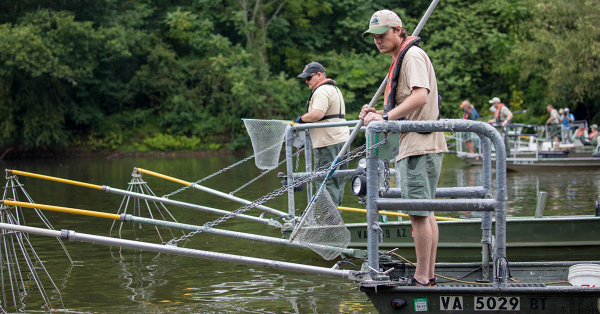 DWR biologists electrofishing while sampling fish populations on a water body. Photos by Meghan Marchetti/DWR DWR biologists electrofishing while sampling fish populations on a water body. Photos by Meghan Marchetti/DWRBy Alex McCrickard, DWR Aquatic Education Coordinator from The Fishing Wire Have you watched some of the videos from aquatic biologists at the Department of Wildlife Resources (DWR) and seen a boat outfitted with long, wand-like poles with dangling cables? Have you ever showed up to a river or stream and witnessed a crew of biologists with large backpacks and long rods extending into the water? This unusual-looking activity is called electrofishing, and it’s modern science in action. 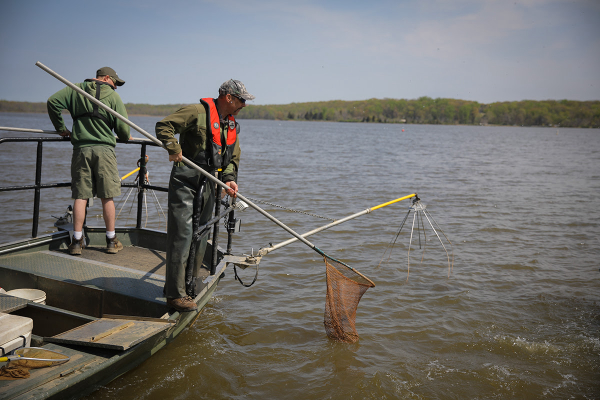 Electrofishing in action.As Virginia’s state fish and wildlife agency, DWR is responsible for the management of our fish and wildlife resources for the benefit of the public. Our agency staff work hard to conserve and protect our freshwater fisheries across the Commonwealth. The best way to monitor the health of fish populations is to catch a number of fish from one area at one time. While our aquatics biologists are all excellent anglers, there is a more efficient, safe, and effective way to catch the fish! Electrofishing in action.As Virginia’s state fish and wildlife agency, DWR is responsible for the management of our fish and wildlife resources for the benefit of the public. Our agency staff work hard to conserve and protect our freshwater fisheries across the Commonwealth. The best way to monitor the health of fish populations is to catch a number of fish from one area at one time. While our aquatics biologists are all excellent anglers, there is a more efficient, safe, and effective way to catch the fish!Electrofishing is a common method used in fisheries science; this type of biomonitoring is truly one of the most effective ways to monitor our fisheries. Fish can really help tell the story of the health of a certain waterbody. They are in the water 24/7 and are constantly exposed to the elements. Some species are more tolerant to pollution than others. The make-up and diversity of a water body’s fish population can help tell the story of water quality and inform our agency’s biologists. In turn, all of this influences sound management decisions that can improve habitat, water quality, and fish health, which benefits the general public and anglers who cherish Virginia’s freshwater resources. So, you now might be wondering what exactly happens during electrofishing? What’s going on behind the scenes during these surveys? Our electrofishing FAQs below cover these basics. What is electrofishing? Electrofishing is a technique used in fisheries science to sample fish populations. Sampling is when biologists study a number of fish from a certain area, measuring and examining them and recording the statistics. When biologists electrofish, a generator or battery gives off an electrical current that runs through the water. Volts, amps, and frequency can be adjusted based on water temperature, conductivity, and other variables. Electrofishing can take place on foot with a backpack unit on a small stream or river. For larger rivers and lakes, electrofishing typically takes place from a boat or barge. From a boat, the anodes enter the water from a long boom off the bow. Electrical current travels from anode cables back to the cathode(s)–in many cases, the metal hull of the boat acts as the cathode. The electrical field typically expands 5 to 7 feet in circumference from each anode and down about 6 to 7 feet. The size of the electrical field can vary depending on conductivity, voltage, and frequency of electrical current. Fish are temporarily stunned as the electrical current causes their muscles to contract. The fish then float towards the surface where they can be easily netted. Is electrofishing harmful to fish? Electrofishing has the potential to be harmful if not used properly; however, biologists have the training and experience to operate the equipment safely and effectively while minimizing impacts to fish. Prior to any sampling, biologists adjust and monitor electrofishing settings to the target species in a particular habit. In some cases, electroshocking is avoided during spawning periods and habitats of certain rare and endangered species to eliminate even the perception of harm. Does electrofishing affect different species of fish differently? Yes, the frequency of the electromagnetic current can affect species differently. For example, low frequency electrofishing tends to only affect catfish species. When we sample tidal rivers to assess the catfish populations, we solely use low frequency. High frequency sampling is often used for standard community assessment of multiple species. Because of their larger surface area, big fish such as bass and muskie are more susceptible to electroshocking than small fish such as minnows and darters. Electrofishing is only efficient in shallow water, so sampling is usually conducted when all species and sizes of interest are likely to be vulnerable to this technique. Why do DWR biologists electrofish? What’s the goal for sampling and what do DWR biologists do with the fish during electrofishing? Electrofishing is an effective method to assess the health of a fishery in a non-lethal manner. It allows biologists to evaluate the health, variety, size distribution, and abundance of fish species on a given body of water and how that population can change over time. Length and weight measurements further allow biologists to assess overall fishery health. This type of sampling allows DWR to look at interactions within a fish population. Furthermore, we can track status of endangered and threatened species or the status of spread of any invasive species. All of this information influences sound management decisions that benefit the public who recreate on these resources.DWR staff weigh, measure, and evaluate the fish netted during electrofishing, keeping careful records of the information. The information collection during electrofishing helps DWR fisheries biologists make sound management decisions for fish populations. Is electrofishing safe for the DWR biologists? Yes, because of their training and experience, DWR biologists are safe when electrofishing. Our biologists wear non-breathable waders that keep them from being shocked while using backpack electrofishing units. For electrofishing boats, numerous electric cut-offs are in place to prevent accidents, and the boat is grounded. All DWR biologists wear personal flotation devices while sampling on boats. DWR biologists have also had formal training in electrofishing principles and techniques (for example the U.S. Fish and Wildlife Service electrofishing course), which contributes to the safe operation of electrofishing gear. 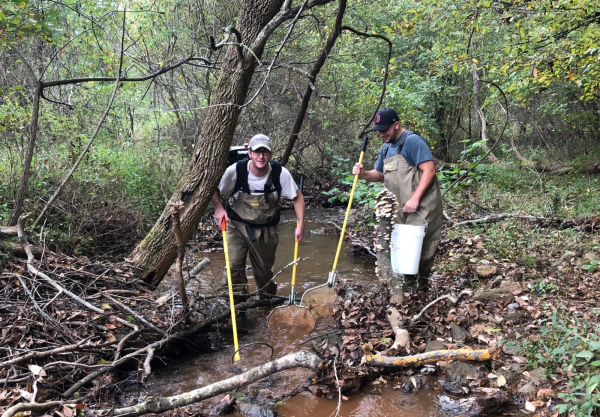 Electrofishing a stream with backpack equipment. Electrofishing a stream with backpack equipment.In what kinds of waters do you electrofish? Electrofishing takes place in freshwater and tidal freshwater rivers and streams. Because of the high conductivity of saltwater, it is not conducive to electrofishing. Can anglers use electrofishing equipment to catch fish? No, it is unlawful for the general public to use electrofishing equipment to catch fish. |
Winter Woods Walks – with A Gun
“All the leaves are brown, and the sky is gray.” Although I went for many a walk on a winter’s day, unlike the Mamas and Papas in California Dreaming, I would have to say the leaves are gone, not brown. The woods and fields in winter are stark but beautiful.
My winter day walks always included a gun. Most days, from the time I got it for Christmas when I was 12 years old, it was my semiautomatic Remington rifle with the 17-round magazine. It had a variable three to nine power scope on it.
Sometimes I carried my single shot .410. Those days I planned on kicking brush piles on field edges hoping to jump a rabbit. My usual luck was to jump a rabbit when carrying my .22. I shot at a few with my .22 but never hit one. I shot many squirrels with my .410 but preferred the .22.
I was a little jealous of my friend Hal with his over and under .22 and 410. He could switch from rifle to shotgun with the push of a button. But both were single shot, and I liked having multiple rounds in my .22 rather than having to take my eyes off a squirrel I missed to breach the gun and load another round.
I loved my scope, too. Even with good eyes back then, it was amazing how a gray squirrel could run up a big oak tree and disappear. Sometimes there was a hollow for them to hide in, but often they just hunkered down tight to a limb and didn’t move.
About the only way to find them was to scan every limb with the scope, mostly looking for tell-tale ears sticking up. I often gave up before finding them. But sometimes a nest was the logical place for them to hide. The balls of twigs and leaves were very obvious in the leafless tree.
With my .22, I sometimes shot into the nest. I could tell by the sound of the bullet if I hit a squirrel. Since I was shooting blindly into the nest, it was usually a wounding shot and they would crawl out and fall. But I climbed more than one tree to get to a squirrel I heard my bullet hit but did not come out. Finding a wounded one while hanging from a high limb was always a thrill.
I got very frustrated one day when I shot a squirrel and it fell a few feet then got tangled in vines. I could not climb that tree, its trunk was too big to hug and there were no lower limbs. I shot that squirrel and the vines around it many times trying to knock it loose but never did.
All winter when hunting that area, I would go by the tree and look at the carcass of the squirrel that frustrated me so much. I hated to waste meat.
Cold winter days often meant building a small fire to warm my hands while in the woods. On dry days it was easy, with dead leaves and twigs littering the ground. Wet days were a challenge, but finding a cedar tree with somewhat dry lower dead limbs and peeling dead bark near the trunk usually meant success. And I always carried strike anywhere matches with their heads dipped in wax to keep them dry.
Take a winter walk in the woods and enjoy the beauty. Deer season is over and the woods are mostly empty, so you can relax and enjoy yourself.
….
Ice Fishing Goes Alternative
Five Top Hardwater Hacks, Off the Radar
By Ted Pilgrim
from The Fishing Wire
This isn’t one of those articles giving props to piles of mainstream, traditional ice fishing tackle. For that, you might simply step in to your local outdoor store and buy an ice auger, shelter or lure from any of the established brands. Or run a Google search on the aforementioned items; there’s no shortage of advice from which to form an opinion.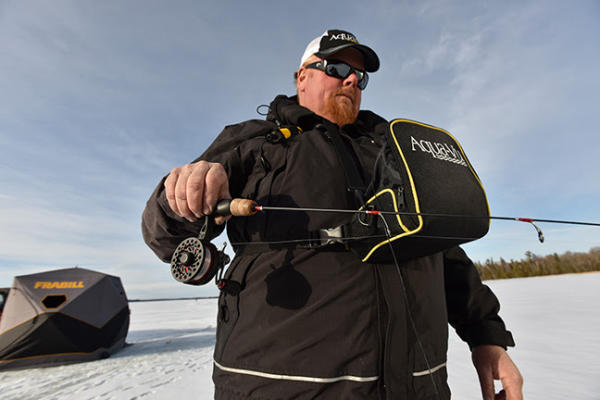 Wearable ice accessories greatly increase mobility, comfort and fishing efficiency.
Wearable ice accessories greatly increase mobility, comfort and fishing efficiency.
That said, try searching for alternative ice gear, or secret ice fishing tools or hardwater fishing hacks. Good luck.
Somewhat of a non-conformist himself, ice pro Brian “Bro” Brosdahl probably says it best: “Some of the most valuable ice gear I use every day sort of gets taken for granted,” asserts Bro, who routinely zigs when crowds zag.
“It’s like those key role players on a football team; the gear that really deserves credit for a great day on the ice mostly goes unacknowledged. Worse, some of these tools are totally ignored and unused by anglers. Truth is, there’s a whole bunch of pretty cool equipment you’ve probably never seen before that will absolutely enhance your time on hardwater. Some of it deserves the daily MVP award, though you might totally take it for granted.”
#1 – WEAR YOUR UNDERWATER GLASSES
Hidden among haystacks of traditional ice gear is an alternative trend toward wearable tackle and gear storage, as opposed to stuff you’re forced to drag around like a third wheel. “I wouldn’t call it a trend exactly,” Bro interjects. “I mean, it’s mostly the tournament anglers on national circuits like the NAIFC who are literally wearing their underwater cameras and their tackle around their torsos.”
Couple winter’s back, NAIFC National Champs and three-peat Team of the Year winners Brandon Newby and Ryan Wilson helped the underwater camera inventors at Aqua-Vu design a wearable case compatible with its Micro viewing systems. “The motivation for designing the Micro-Mobile Pro-Vu Case,” says Newby, “was one of necessity, and of our need to find untouched fish. For us, a portable Aqua-Vu Micro camera lies at the heart of finding fish and structure—whether we’re prefishing a tournament or hitting new water.”
Designed to fit any size angler, the Pro-Vu Case sports dual adjustable straps, positioning the camera screen across the angler’s upper torso. The softcase itself features a large zippered camera compartment with a built-in protective cover, plus extra storage for a cell phone, keys and small tackle necessities. “We can drill holes, jig or rig lines and always keep the camera at the ready. The hands-free design of the case even lets us fish and underwater view at the same time. For us, it’s an absolute must-have piece of equipment.”
#2 – ACCESSORIZE YOUR ICE SUIT
Continuing the wearable tackle trend, Frabill offers a similar apparel accessory. “Don’t know about you, but I like to fish in stealth mode,” notes Bro. “Carrying a small, all-star selection of jigs, plastics and other necessities in a single wearable case is a luxury. The fact I can use it as a hand warmer—priceless. Probably not one in ten anglers knows what I’m talking about,” he laughs.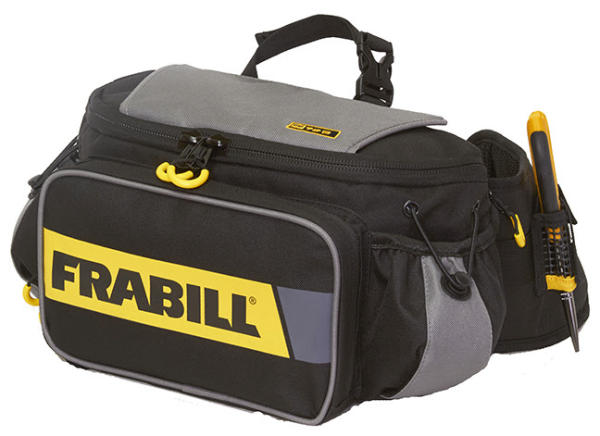 Frabill Tackle Pack/Hand Muff
Frabill Tackle Pack/Hand Muff
Fitted to be worm around the waist, Frabill’s Tackle Pack / Hand Muff is the only wearable tackle bag doubling as an easy-access hand warmer. “Fact is, a lot of us fish without gloves—especially during a frenzied bite,” notes Bro. “The Tackle Pack fits right across my food shelf (Bro-speak for love handles). Not only can I quickly access a fresh jig or plastic tail without getting up and digging into a pile of gear, but I can also throw a couple hand warmers inside the insulated hand muff for an instant warm up. Eliminates downtime. Definitely puts a bunch more fish on the ice for me, every day.
“We’ve long said our ice suits serve as our wearable shelters. I just take it one step further.”
#3 – PERFORM PANFISH DENTISTRY
Technically, the next nouveau tool can also be worn, or just as easily tossed into one of the four-dozen pockets sewn into your ice suit. A Panfish Toothpick is pretty much what it sounds like: a slick little device that safely, easily extracts a fish’s last meal from betwixt its bony jaws. The Toothpick pops free even those troublesome hooks lodged way back in the larynx. The name of the game is preserving your expensive premium hooks, tungsten jigs and other valuable lures. Performing the procedure with minimal stress on fish is a beautiful benefit.
“Grabbing an impaled jig with a forceps or pliers scratches and flakes lure paint and can bend or break your fine wire FISKAS Wolfram Jigs,” notes Jamie Olson, ace angler and proprietor of Your Bobber’s Down, Inc., an online retailer of elite-grade fishing tackle and hard-to-find accessories.
Both the Panfish Toothpick and new larger, T2 Toothpick feature a specialized V-slot. Apply quick direct pressure on the hook bend, backing the barb out and cleanly removing the lure. A ton of top-level anglers now use the Toothpick, says Olson, many of them having now removed pliers and hemostats from their lanyards altogether.
#4 – THE LONG & SHORT OF IT
Despite the fact most ice fishers choose 25- to 30-inch ice sticks, huge advantages highlight both longer and much shorter rods. Case in point, St. Croix Rods’ 48-inch Legend Black ice rod, considered crazy tall for an ice wand. Among anglers who prefer to stand while fishing, to keep the rodtip close to the water surface for bite detection and to prevent line freeze, a longer rod can be an exceptionally valuable tool. Moreover, for flip-and-dip style shallow water fishing, an angler can simply keep a two- to four-foot length of line hanging from the rodtip, allowing for instant and rapid-fire fishing through multiple holes fast. Finally, a longer rod provides superior shock absorption, vital for battling large, fast-surging fish such as pike, lake trout and big walleyes.
At the other end of the spectrum are palm rods, curious 12- to 18-inch all-in-one rod/reel combos capable of fishing the tiniest lead or tungsten jigs with utmost finesse. Particularly for shallow water panfish, European-born palm rods serve as superior bite detectors, most of them, like the Jonttu Sport Special, armed with adjustable, super-responsive strike indicators. Top anglers consider a palm rod to be an extension of their fishing arm, spooled with wispy 1-, 2- and 3-pound test tied to jigs weighing under 1/64-ounce.
#5 – SNELL IT
Staying with the scaled-down panfish theme, one of the biggest off-the-radar movements waiting in the wings are so-called through-head tungsten jigs. Another Eastern European contrivance, many of these elite designs lack a true line tie. Instead, they feature a small hole bored through the metal itself. A specialized, though simple, knot known as a snell or Marka knot secures these amazing jigs to your line, maintaining a perpetual horizontal posture—no repositioning of the knot required. Note: You can also use this knot with standard line-tie jigs for the same horizontal benefits. Finally, because the knot itself is recessed onto the hook shank, retying isn’t required nearly so often—and the snelled line itself can be used to secure soft plastic baits in place.
Alternative ice angling is little more than rethinking convention, taking the next step beyond “normal.” Time to embrace new or off-the-radar tools and techniques . . . before they become yesterday’s news.